I was at the World Heritage site, Aphrodisias, again. What did I see?
Visiting places where history comes to life can cause strange feelings to arise and remind us of our transience. In fact, these are exemplary records. A lesson for all of us about where humanity came from, what it went through and what was accomplished. The lands we live in have hosted various civilizations throughout history, one of them being Aphrodisias.
Eighteen places in Turkey are on the World Heritage List, and Aphrodisias is among them. This ancient city was discovered in 1958, when the photographs that master photographer Ara Guler took when he had lost his way in the village of Geyre, which included historical artifacts, were published in the National Geographic magazine. Excavations were carried out in 1961 under the direction of Professor Dr. Kenan Erim. Later, in 1986, the Geyre Foundation was established to raise funds for these works, and excavations continue with the efforts of the Foundation until today. As pladis, we have been supporting the Geyre Foundation for some of these excavations for four years because this is a very valuable work for Turkey’s tourism and cultural climate. In the excavation area that we support, the public building called the “basilica” which was used both as a palace of justice and as a trade center during the Roman period, has been unearthed. Recently, I had the opportunity to visit Aphrodisias and the excavation site again, and I excitedly wanted to tell you what I saw and what remained in my mind.
-If you wonder why August is called August, the answer is in this article.
– Why are the stair piers built so high? It is difficult to go up and down. I don’t know why?
– The room doors have always been low throughout history, you can only enter by crouching down. Was it a sort of privacy notice?
If you are interested in this historical richness of our land, please read on. 😊
Aphrodisias was discovered in 1958, when the photographs that master photographer Ara Guler took when he had lost his way in the village of Geyre, which included historical artifacts, were published in the National Geographic magazine. Afterwards, Prof. Dr. Kenan T. Erim came to Aphrodisias, became fascinated, and started excavations in Aphrodisias in 1961. Since that day, the work has been ongoing, and it will continue for a while in our lifetime.

If you ask what the history of this city is, this city, within the borders of the ancient Caria region, lived its golden age during the Pax Romana (Roman Peace) period. Due to its proximity to the marble beds, very magnificent structures were built. It takes its name from the goddess of love and beauty, Aphrodite, because, at that time, sacred ceremonies were held in her name in this region.

This city is a center of architecture, art, and sculpture and the excavations carried out so far show that it was founded in 4000 BCE. It has been called by various names throughout history. “Ninoepolis which comes from Ninos, the semi-legendary king of Assyria, Lelegpolis which means the city of Lelegs, Caria, as it is in the Caria region, Aphrodisias due to the existence of the Aphrodite sanctuary, and finally Stavrapolis, due to the collapse of paganism and Christianity being accepted as the official state religion.”
Roman Emperor Julius Caesar (Caesar) preferred this place to rest after his Anatolian expeditions. When his successor, Augustus Octavianus, was asked where he would choose if he were to choose a capital, he would answer “Aphrodisias.” As you already know, the Roman Empire was experiencing its golden age with his takeover of the administration and became the only dominant state in the world. In the period between the first and third centuries BCE, many buildings were built in the city and there was a serious development in areas such as culture, art, and sculpture.
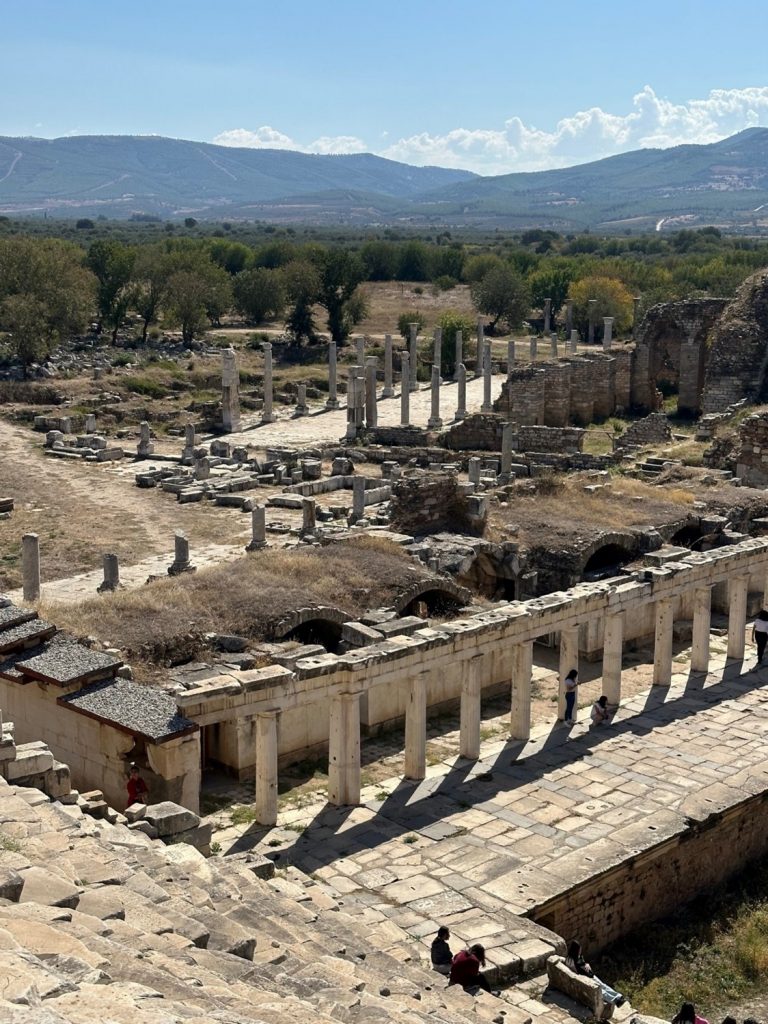
As I said before, the region is very close to where the quality marbles on the outskirts of Babadağ come from. This soft marble, which can be easily processed, is also very suitable for carving. In addition to cream-colored marble, stone masters have acquired the ability to remove the veins of black and white marble in a single block over time. Also, when the sculptors who migrated from Pergamum came to the region, a sculpture school was opened, and works that were exported all over Rome began to be produced.
There is a name we should not forget when talking about this city; Gaius Julius Zoilois was from Aphrodisias and was later sent to Rome as a slave. At that time, he participated in many wars with Emperor Augustus and won his friendship with his talent and courage. After his emancipation, he continued his life as a strong and wealthy person. Thanks to him, Aphrodisias was exempted from paying taxes to Rome. Thus, the region became more suitable for trade. Wealth and prosperity increased even more. For this reason, the people were devoted to their Emperor Augustus, and he was so loved that they named him after the month he was born. We still use this name, actually “August.”

On October 6, I did a GOYA of this enormous area. The architect of the excavation, Thomas Kaefer, has been working here for 33 years. He came from Vienna. This year they have succeeded in putting out two new columns. These came up in pieces in excavations; they carefully match the relevant pieces and prevent them from falling over by running a steel pipe through them.
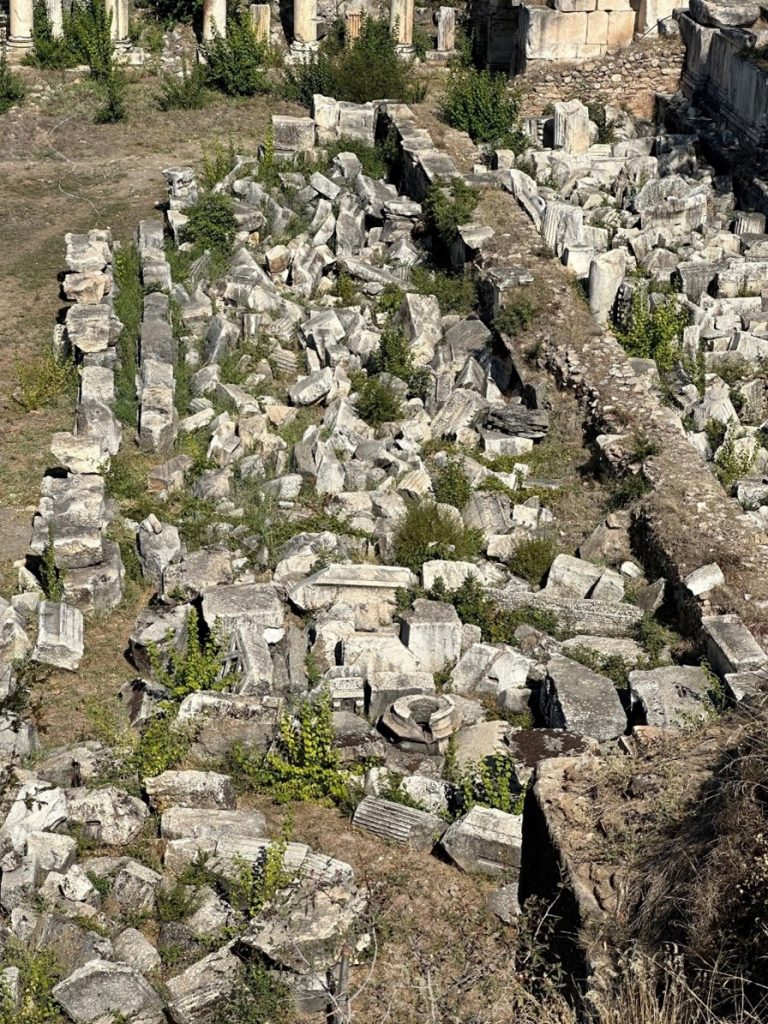
I asked him about the unpaired stones that were unearthed in the area, and he said, I guess I won’t see them paired in my time. Their job is like digging wells with a needle. There are 30-35 students and 60-70 workers working in this area every year during the summer season. In winter, the team pauses their work because the weather is not suitable for archaeological excavations.

In the city, the bath, agora, temple, stadium, theater/assembly area for eight thousand people, city walls, acropolis, and odeon are the structures that are still standing today. If you pay attention, the height of the stairs in the city, namely the piers, is quite high, more than 20 cm. This is the case in the whole of Antiquity and even in the Ottoman Empire; it’s hard to go up and down, but I think they chose this method for ease of construction. Room doors are always low, too; for some reason, perhaps a privacy warning! Anyway, I’m waiting for your comments.
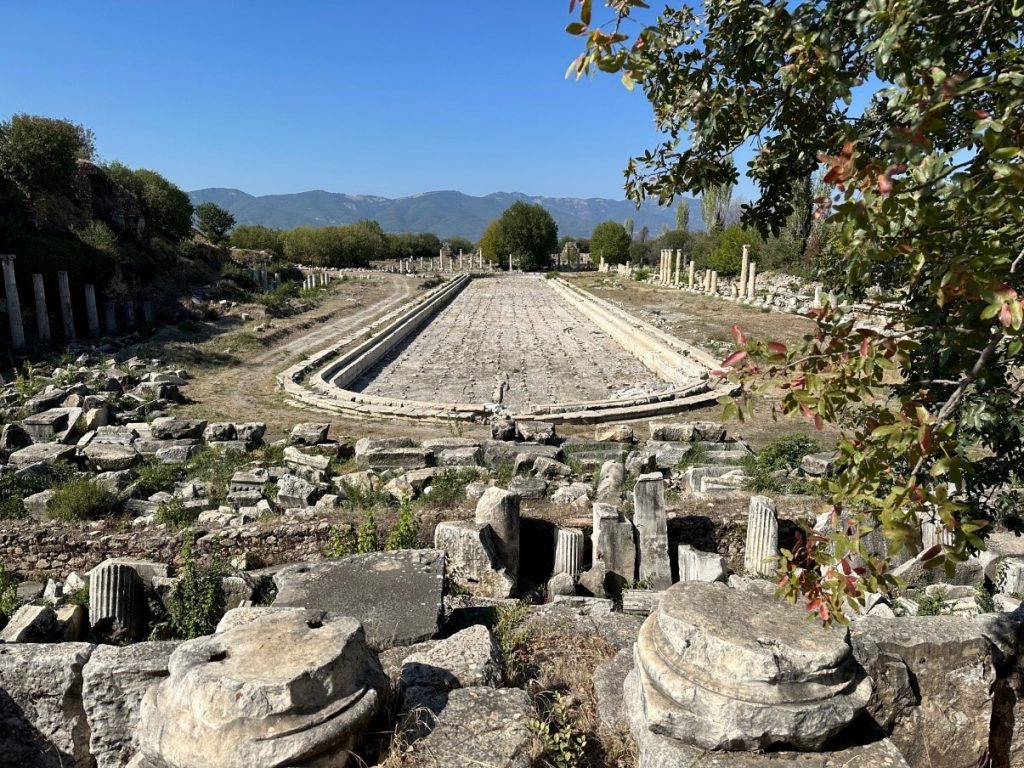
While walking around the area, you come to Palm Park and the pool from a road like “Madison Avenue.” The pool is quite large, but it was not used for swimming; it was an ornamental pool for a cooling effect.

There is a lot of graffiti around the pool.

No cement or binding material was used in this tunnel. It is made with a key block system. While walking through it, we saw that there were signs of the cross on the wall because they believed that there was a devil in the stones and that the cross would protect them.
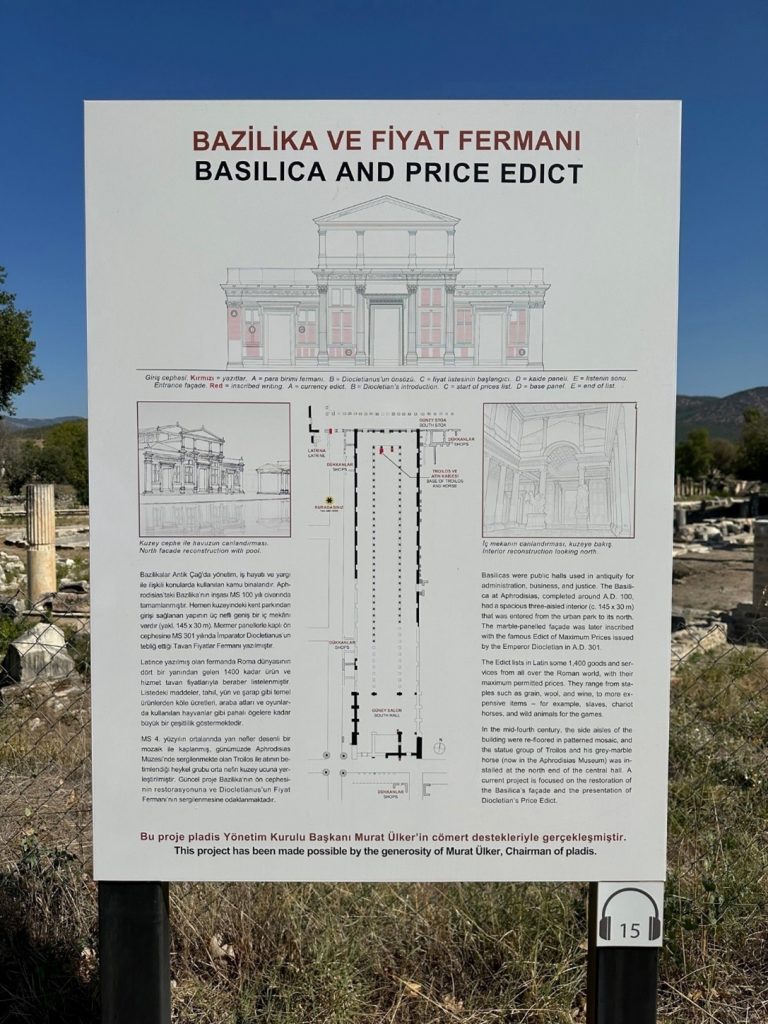
The area that we have helped to uncover by supporting the Geyre Foundation, under the sponsorship of pladis, is the “basilica.” The basilica is actually a public building; it was used both as a palace of justice and a “shopping mall.” Looking towards the plaza. It was built in the first century CE, and they brought the marble from 2 km away; they had cranes and, of course, enough time and manpower. The most important part of this building is the “NARH LIST” (ceiling prices) on the front. To date, 40 similar edict fragments have emerged in the Eastern Mediterranean Basin. But in Aphrodisias, more than half of the text has been uncovered, a first (**).

If you wonder what it says, there is a lot of information from a first-class African lion to attorney fees, from wheat to turnips, from the wages of the bath attendants to the sale prices of slaves. The most comprehensive version of this 1400-item edict in the world concerns many social sciences such as history, art history, sociology, and economics, as well as archeology. It is also planned to be published as a book in the future. This appealed to me as well; being the first and being a political economy – ancient document! Let me also add: In his edict, the king of time threatens to behead those who do not comply with this maximum price list. But in history and today, these lists have never been long-lasting, and nobody’s head has been cut off. I guess that’s the jargon of the discourse.
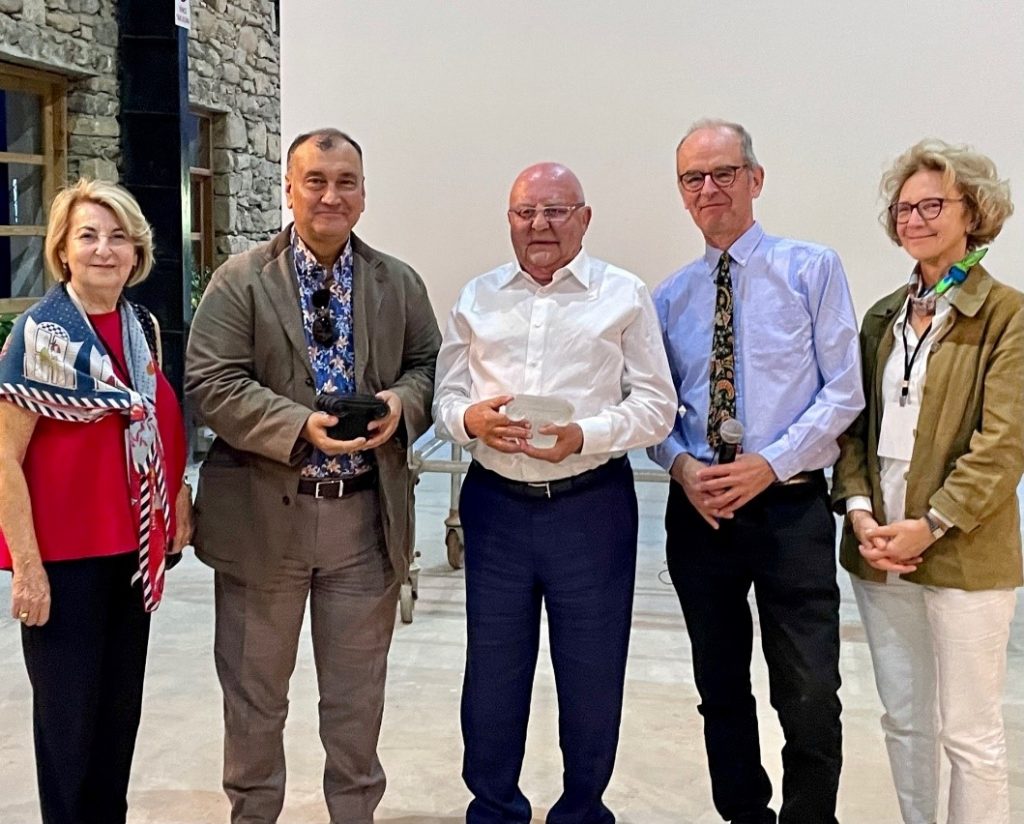
I would like to take this opportunity to thank the Geyre Foundation for this memory of gratitude they have given me. I think everything I said is very valuable. I am happy that something so important about world history arose from our lands and we contributed to the meeting of it with the world to some extent. #makehappybehappy.
I believe that these excavations will not only contribute to the culture and arts climate of Turkey but will also provide a significant benefit for tourism.
By the way, while I was visiting, I learned that the top of the ancient ruins is covered with half or 1 cm of dust every year. Then I thought, in fun, what would they think if someone came and dug the land where we live today thousands of years later, for example, the Karacaahmet cemetery; they would probably say that people worshiped brands or they were not civilized because no finds were found in their graves, or they would say that their god was called BIC. If you ask why, the plastic pen, which is commonly found in everyone’s breast pocket and which they will not bother to pick up if accidentally dropped into the grave during burial, maybe the only thing left behind after many years. 😊
(*) Https://Www.Kitantik.Com/Product/HORIZON-A-MAGAZINE-OF-THE-ARTS-ARA-GULER_0z8kgltj9ugcv8e12rj
(**) https://www.milliyet.com.tr/kultur-sanat/afrodisias-kazilarinda-onemli-ferman-kesfi-6844609
Note: This open-source article can be quoted by citing the author. No copyright is required.

